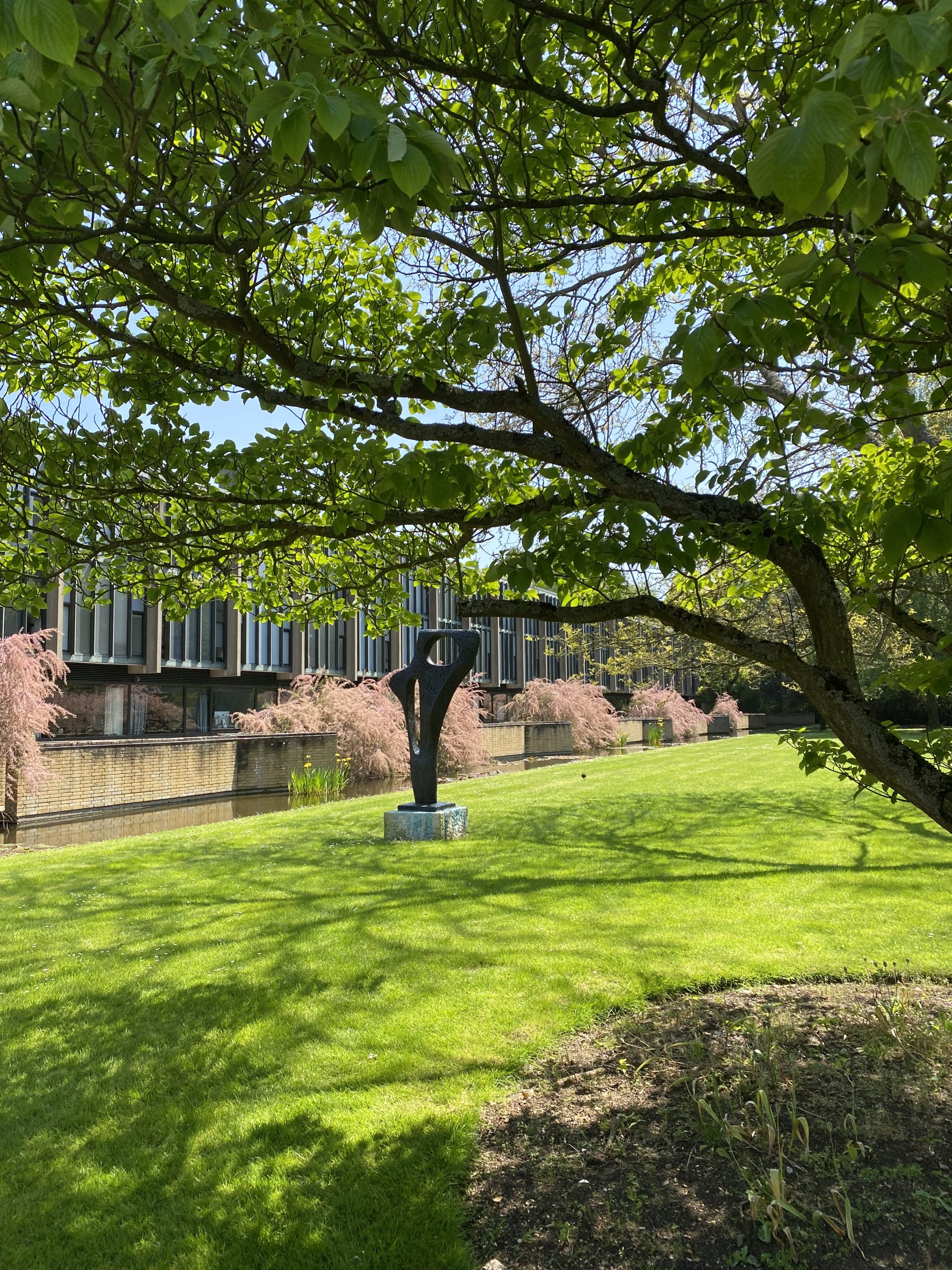Icon of the Week: In defence of ‘Catz’
by Kelsey Moriarty | June 2, 2024

Yes, I know. Hear me out.
I’m being defensive, but my time at Catz has made it almost instinctual; it is such a point of such contention in the wider Oxford community – it sticks out like a sore thumb among the warm sandstone-yellow buildings and towering spires of Oxford. A quick trawl on Oxfess substantiates this view. One Oxfesser describes it simply as ‘the worst Oxford college’, whilst others dramatically opine on how lucky they are to be elsewhere – ‘every day I wake up glad I don’t go to Catz’. My favourite of them all asks the eternal question, ‘can someone actually name one good thing about St Catz?’. Telling people that I’m at Catz seems to get a reflexive ‘hmmm’ or ‘sorry’ or ‘why?’ Love it or hate it (and don’t get me wrong, there are crowds for both) it is an iconic part of Oxford.
Its origins trace back to 1868–making it “older than LMH!,” as I was told indignantly by a Catz student. It was founded following an 1850 Royal Commission that recommended access to Oxford should be expanded to a ‘larger and poorer’ group of the population. Beginning initially as a ‘Delegacy for Unattached Students’, which allowed students not attached to a college to study at Oxford, Catz grew from there. It successively outgrew locations in Old Clarendon, the High Street, St Aldates, and eventually settled in Manor Road, where it is today. Catz as we know it today was designed by Danish architect Arne Jacobsen, who (famously) designed the college with such great detail that even the fish in the pond are of his selection. The college is made largely from concrete (it’s oft-quoted downfall), with an emphasis on glass and greenery. It maintains some of the more traditional features of Oxford colleges–quads, colonnades, people who say ‘yah’–but is thoroughly modern and disruptive. It is not what people expect of an Oxford college. The design, the culture, the all-round vibe–our motto is nova et vetera, meaning the new and the old–is subversive. Its very existence runs counter to what we understand Oxford to be. Jacobsen did not want to create ‘a sad copy of something old’, and I don’t think you could find anyone that thinks he did. It is a beautiful example of modernist design. Over the years, it has been party to Alan Bullock, Benazir Bhutto, Ben Willbond, and – for some reason? – an episode of The Crown (season four, episode six for the curious).
It has, of course, been notoriously plagued with construction problems. RAAC, or Reinforced Autoclaved Aerated Concrete, has a lifespan of around thirty years before it is supposed to crumble. It is also what about 90% of our sixty-year old college buildings seem to be made of. The buildings have yet to crumble, but the consequence of the use of the material has meant upheaval for life at Catz. Our JCR, Hall, and Library remain blocked off, and college became a primarily tent-based structure almost overnight. It was definitely an interesting adjustment to make. I remember wondering what exactly I would be returning to with most places shut off. The answer, I found, was some interesting wood beams on the ceiling of my room, miscellaneous construction noises, and a group of people I had not seen in months to laugh about it with. We had our Entz in the JCR marquee for a good two terms, and it felt like being at a wedding, in the weirdest possible sense. I would often bump into people from other colleges who were just there for the novelty. Nobody seemed particularly bothered at the time. I had some lovely sober reflections on how the people make the place rather than the other way around, but at the time I think I was just quite cold. Our history of construction issues has been around long before the RAAC revelations last year. A 2004 Cherwell article proclaimed ‘construction chaos’ as new accommodation was not finished before the start of Michaelmas. Students in 2004 complained to Cherwell about ‘large cranes’ and builders ‘removing individual bricks from the building’ for unfathomable reasons. Oh, to have been at Catz in the twenty-year period between construction events!
I did not choose to go to Catz (shock!). I did an open application. I don’t quite know what I was expecting from it – I didn’t want to learn about and get attached to a college and then be pooled or not let in. I remember it distinctly: the people I was applying with did the same and were assigned elsewhere, and almost instantaneously began insulting Catz. I remember seeing it for the first time–in the middle of a drought, no less. I walked into dying. yellowing grass and almost excessively overcast sky, making the grey ignominy that is the collection of buildings seem even more desolate, somehow. It did not (to put it lightly) fill me with hope. But I got in, and I went, and existed there, waking up and walking in and walking out, day after day. And it quite quickly just became the most beautiful place. I mean, you have to walk by a Barbara Hepworth statue, and cross over a moat to get into your room. It’s ridiculous! In the sun it’s another thing entirely–the green space seems to envelope you, and the sun reflects off of the windows, and it feels like you’re existing in a futuristic place miles away from Oxford. And at night, the individual rooms in Old Quad light up and becomes a unique work of art. Each light is somebody up late, drinking, or working, or crying, (my first year involved all three in abundance, often simultaneously); it is never the same on any night.

I do think you have to live there to fully appreciate it–Arne Jacobsen’s work is immersive and intensely conceptual. It seems he thought of everything (except possibly the concrete). To live in a room designed by him is to live according to his very set vision. The windows in Old Quad (first and third year accommodation), for example, stretch from floor to ceiling and essentially make up a wall. So, to live in one of Jacobsen’s rooms is to be constantly on display. Everyone–and I mean everyone–can see into your room. There were quite a few times in first year when I would be waking up shamefully late in the afternoon or getting changed only to make direct eye contact with someone walking by. The window was also directly opposite my bed, and so in summer if I wanted to have it open somebody could quite literally watch me sleep. Your sleeping patterns, eating habits, and sense of interior design can all be quite freely observed. His vision is unremittingly pervasive, shaping everything from the odd and frankly unusable cutlery to slightly numbing feeling one gets after sitting in a Jacobsen chair for too long.
Despite all of this, he occupies a deific position among the students. Before writing this article, I had simply assumed Catz was probably among the greatest and most famous modernist designs ever made. It took one google search during the writing of this article to dispel that notion. Everybody at Catz knows Jacobsen’s name, as well as a strange amount about him–his divorce is supposedly the reason behind the size of the bed and the wardrobes, for example. There is a weird sort of reverence for him that nobody can really explain. I have an ‘I heart Arne Jacobsen’ sticker on my laptop (thank you arts reps) and I couldn’t really tell you why. There is a sort of asymmetry present in the information people at Catz have in relation to others. I will leave with more knowledge about Arne Jacobsen than I will know what to do with. It really does have to be lived in to be believed in! Catz was Jacobsen’s favourite of all his works. Make of that what you will.

Some people, to put it lightly, do not completely buy into the romanticisation of Jacobsen’s architecture. An anonymous Catz student thinks “hate is a strong word…” but “there isn’t much to write home about.” The sense of modernity, they think, is “used as an excuse to excuse… some of Catz’s flaws.” They applied to Catz–which surprised me–but their reasons were academic rather than architectural, saying they had come for a specific tutor (that was good, but possibly “not worth it”, timewise). The people at Catz and their friendship groups are a redeeming factor, but they feel like the administration and accommodation (facilities, not aesthetics) were disappointing. People usually instinctually go for a comment about ugliness or newness; this is something more nuanced, and previously unheard. “Yeah,” they said, “it’s got a weird energy socially as everyone regards themselves as having a separate Oxford experience.” It is indisputably a different experience. Catz’s modernity and attitude to tradition is so different to other colleges. It is unsurprising that this separation can create a disjointed and confusing feeling that would create that “weird energy.” My experience is that this makes people more relaxed and laid-back, not at all bad thing considering the stresses of Oxford. Discovering not everybody feels this way was enlightening. There is, it has to be said, a very ingrained culture here that is at once guiding and liberating. Catz can sometimes feel like almost a completely different university, for better or worse.
Some enjoy this more than others. Ava Martin (2nd year, History) chose Catz for “soooo many reasons,” like the “unique architecture, green space, and accommodation for three years.” “I didn’t want to be in old, creepy, falling down accommodation” she said before adding, “which didn’t go particularly well!” I asked if she would have still chosen Catz if she had known about RAAC, and she hesitated. Buoyed perhaps by the current absence of falling-down accommodation, she said yes, she “probably would have.” Pre-RAAC I did an interview for a book that was being written about Catz. I was (mostly) kind, I think, but I would possibly be kinder now. The way I’ve interacted with the college–the buildings, the people–has changed as I’ve grown. For all its flaws, it has given me some of my best friends and my favourite memories. If you’ve never been, I would recommend a walk around on a sunny day. And, after that, even if you still hate it, you’re definitely going continue to talk about it. What is an icon if not a little controversial?∎
Words by Kelsey Moriarty. Images courtesy of Kelsey Moriarty, graphic courtesy of Natalie Hytiroglou.




